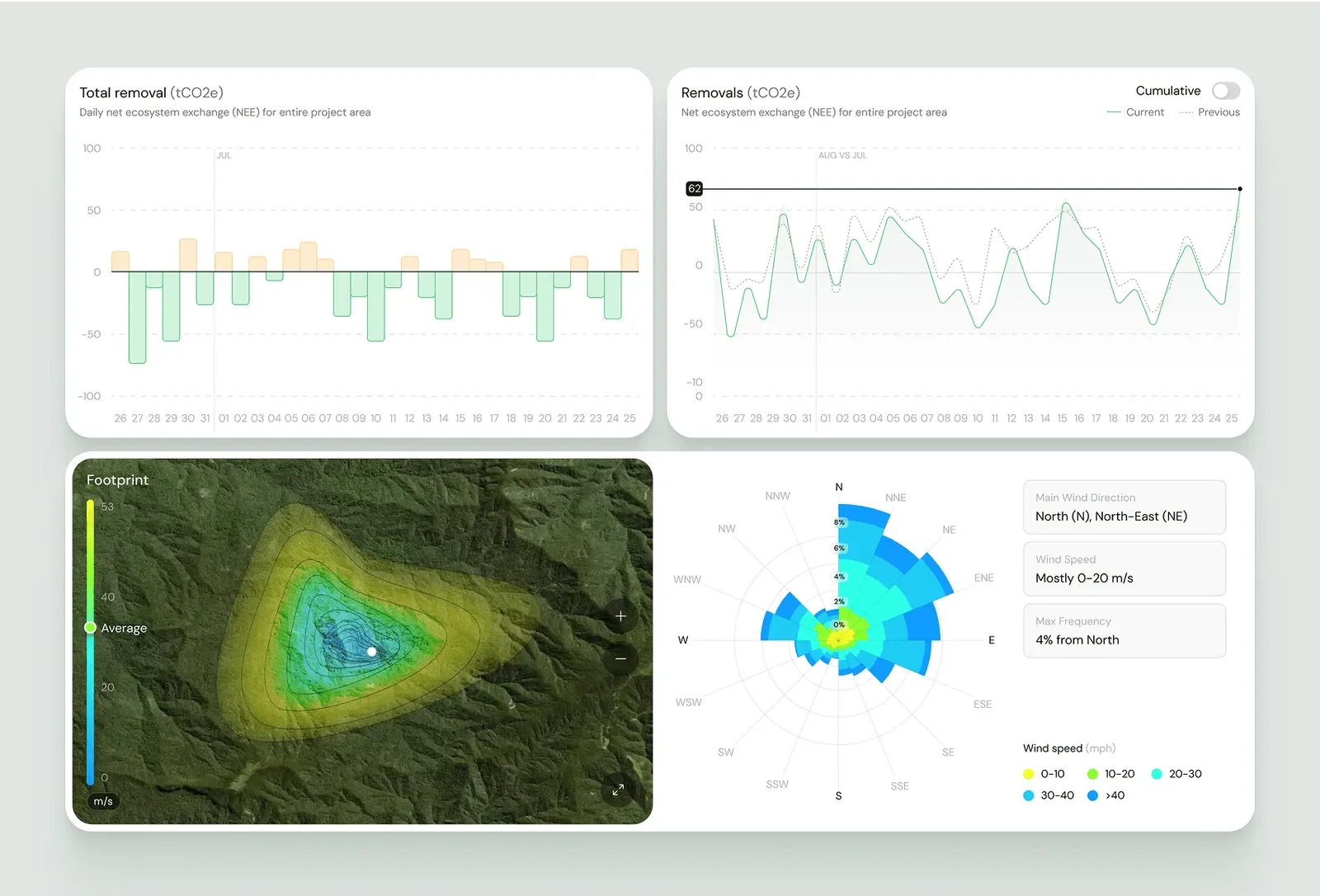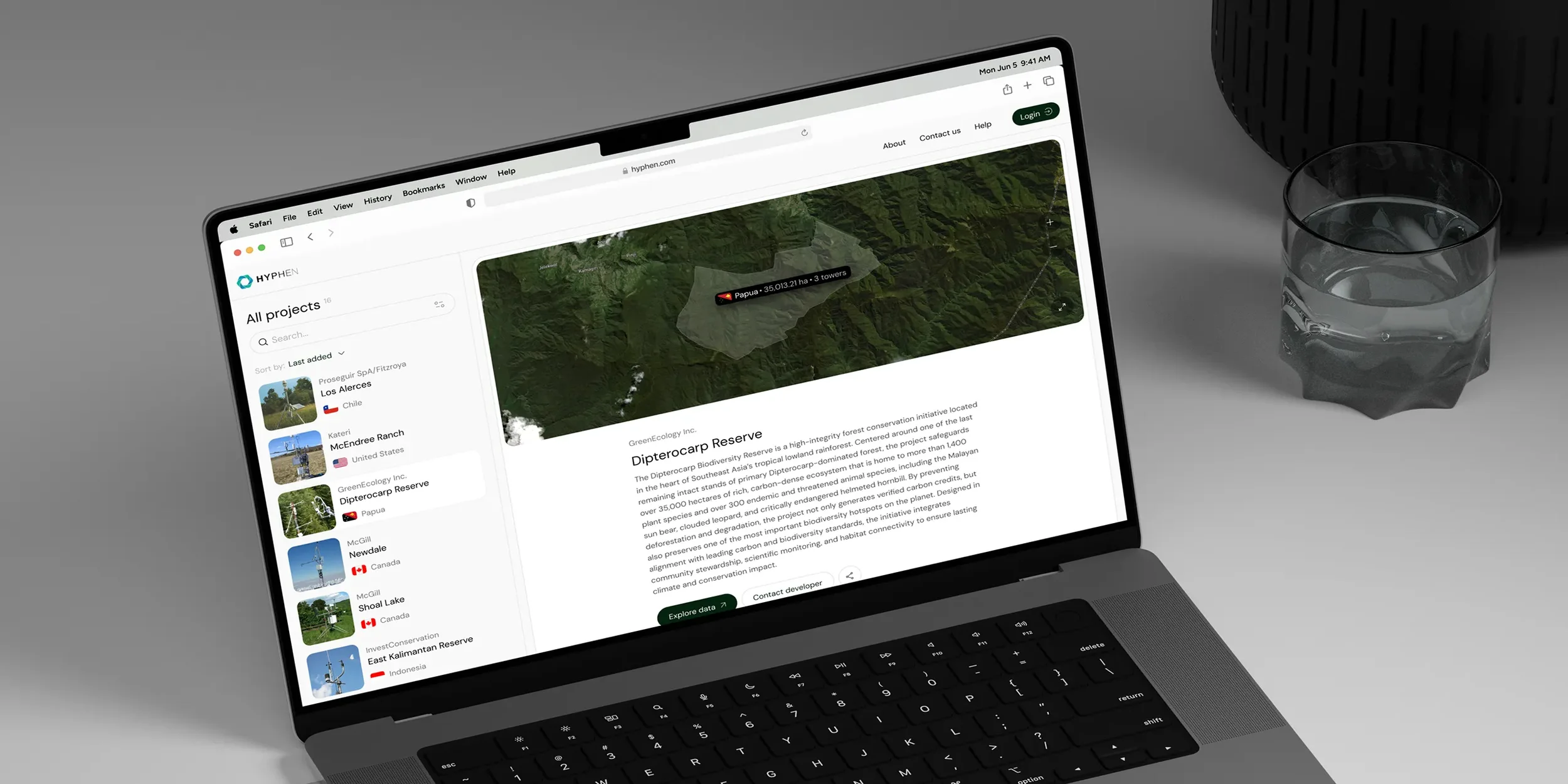Interview with Hyphen: Measuring What Nature Really Does, and Why It Matters for Carbon Markets
Carbon markets depend on confidence, that one tCO₂ removed is truly one tCO₂. Yet much of the system still relies on proxies and periodic sampling instead of continuous, site-specific measurement. In this Ask the Nature Tech Experts interview, Hyphen shares how its atmospheric-based MRV (aMRV) technology measures greenhouse gas fluxes: CO₂, CH₄, and N₂O, directly in real time. By replacing estimates with auditable, near-real-time data, Hyphen is helping rebuild trust, raise quality, and ensure that land stewards and ecosystems are valued for their verified climate function.
Read on to discover how their approach is redefining integrity in carbon markets, and what it means for the future of nature tech.
Image Credits: Unsplash
About Hyphen and Mission
Q. Can you tell us the story of how Hyphen got started, and what motivates your team to work at the intersection of climate and nature tech?
We entered carbon markets as investors, not builders. The thesis was simple: if this is to function like any other market, it needs asset-grade, real-time data and confidence that one tonne is truly one tonne. What we found was a measurement gap driving discounts, delays, and distrust. So we built Hyphen around aMRV—direct atmospheric flux measurement—so that projects report what ecosystems are actually doing in time and space. The goal was to convert credits from claims into observable, auditable assets and let prices reflect measured performance.
What keeps us here is alignment: science, finance, and justice point in the same direction when uncertainty falls. Developers get faster, cleaner issuance; buyers get defensible tonnes; communities and stewards get paid for real ecological function.. Our motivation is to make integrity the low-friction path, continuous measurement, transparent verification, and economics tied to quality. Markets will adjust around that foundation. That’s the intersection we work in: turning living systems’ performance into financeable, accountable value.
Screenshot: Hyphen’s aMRV software
Q. Where do you see Hyphen’s biggest contribution when it comes to tackling climate change and supporting nature?
Hyphen’s biggest contribution is giving the carbon market something it’s been missing: accuracy and certainty through real-time, continuous measurement of greenhouse gas removals. Today, too many nature-based projects are assessed and valued on estimates. We change that by measuring and quantifying greenhouse gas removals directly: CO₂, CH₄, and N₂O, showing in real time what nature is actually removing 24/7/365.
That certainty matters for climate and for ecosystems. In forests, our systems can quantify not only carbon removal but also methane removal, a climate benefit that is almost invisible in today’s markets. In agriculture and rangelands, we can track nitrous oxide, which is 270× more powerful than CO₂. With that level of precision, projects earn stronger trust, higher prices, and more funding to protect biodiversity and livelihoods.
Across any ecosystem, real-time precision GHG quantification delivers immediate feedback, empowering land stewards with the insights needed to adjust and effectively manage mitigation efforts as they happen. From agriculture to forests and beyond, this represents a true game changer.
Technology and Approach
Q. For someone new to your work, how would you explain what Hyphen does and why your approach to monitoring matters?
Most carbon projects today are built on estimates, or approximations and proxies. Soil samples taken every few years and satellite images that can’t directly measure greenhouse gases often leave projects with ±30–70% margins of error. That makes nature-based carbon credits underpriced, over-buffered, and distrusted.
Hyphen solves this by putting science in the field. We install flux towers that continuously measure CO₂, CH₄, and N₂O—the three most important greenhouse gases. This means every ton of carbon removed or emitted is directly measured and quantified, not inferred. Our system runs 24/7, delivering ~90% accuracy.
This matters because better impact measurement rebuilds trust in the voluntary carbon market. Developers bring projects online faster. Buyers get credits backed by direct data. And ecosystems receive the funding they deserve to protect biodiversity and livelihoods. In short: Hyphen makes climate impact real, visible, and investable.
Q. Could you share a concrete example of how your data has helped a project or community make better climate or conservation decisions?
Regenerative farmers face a constant challenge: balancing maximum yields with reducing emissions. The difficulty lies in assuming that specific practices produce specific outcomes—without truly knowing. Traditionally, farmers only see results every 1–3 years through soil sampling, leaving them with no clarity on which mitigation practices actually contributed to the outcome.
Hyphen changes this. With our real-time, direct measurement system operating 24/7/365, farmers can apply a product or implement a new practice in the field, then immediately see its GHG impact. For the first time, farmers have real-time intelligence to guide informed decisions, which maximizes GHG reductions while increasing yields.
Image Credits: Hyphen
Science and Storytelling
Q. You’ve spoken about the role of data and storytelling in climate action. Why do you think stories backed by solid data resonate, and how does Hyphen help tell those stories?
Stories shape how people see the future. Data shapes what they believe about it. In climate action, one without the other falls flat: data alone can feel abstract, while stories without proof risk being dismissed as wishful thinking. When you combine the two, you create trust and momentum. A community protecting a forest doesn’t just say we’re making a difference—they can show atmospheric data proving that forest is removing hundreds of thousands of tons of CO₂ each year.
That’s where Hyphen comes in. Our monitoring systems give nature a measurable voice. We capture the invisible—GHG moving between land and atmosphere in real time—and turn it into clear, auditable numbers. Those numbers are then woven into narratives: a forest that isn’t just standing but actively removing carbon; a farm that isn’t just sustainable but measurably reducing emissions.
By grounding powerful stories in verifiable data, Hyphen allows developers, investors, and communities to tell climate stories that markets, policymakers, and the public can believe in and act on. That mix of truth and vision is what builds trust, unlocks capital, and accelerates change at scale.
Q. Based on your research, what’s one thing you wish more people understood about forests or ecosystems?
One thing we wish more people understood: standing, intact forests don’t “stop working.” They keep removing greenhouse gases—year after year—and even help with methane, especially via woody surfaces in mature trees. Markets rarely recognize these ongoing removals of mature biodiversity rich ecosystems, so we chronically underfund the very ecosystems that are stabilizing climate in the background the most.
This opens the door to the possibility, in which the market equally values removals from afforestation and reforestation as well as removals from standing, mature forests – not just for avoiding future loss or avoided emissions from planned and unplanned deforestation, for example. Ecosystems should be valued and compensated for the removal service they provide.
When you can prove the removal and its permanence, you can price it. With aMRV, these payments can be tied to what the forest actually removes each day, including methane dynamics that today’s methods miss. Enabling markets to buy measured, ongoing removals from standing forests is one of the fastest ways to support nature while tackling climate at scale.
Image Credits: Unsplash
Collaboration, Clients, and Partnerships
Q. How do you usually work with partners, whether that’s other companies, scientists, or local communities?
Partnership is built into how we operate. We co-design projects with developers, scientists, and communities from the first feasibility study to the moment credits are issued. Step one is always listening and assessing: what does the land look like, what are the goals, and how can real-time atmospheric data strengthen the project’s story and value.
With companies and project developers, we take responsibility for the heavy lifting—from installing and calibrating flux towers to ensuring data is market-ready. With scientists, we align every deployment to ICROA-endorsed methodologies and decades of peer-reviewed protocols, making sure our measurements meet the highest scientific standards. And with local communities, we build systems that are off-grid, low-impact, and designed not to interfere with ongoing land use. The result is infrastructure that supports livelihoods instead of disrupting them.
When the data begins to flow, we stay engaged. Our software translates raw atmospheric signals into verified tons of GHG, feeding directly into registries and exchanges. Partners can then tell their story with evidence: a forest that absorbs more than it emits, a farm that cuts nitrous oxide, a community project that generates premium-quality credits. That’s how we connect partners at every level—scientific, corporate, and local—to markets that reward measurable climate impact.
Q. Is there anything the NTC network could do to support Hyphen right now?
Advocate for atmospheric-based MRV as a market norm
The carbon market is stuck with ±30–70% uncertainty because it still relies on proxies and infrequent sampling. NTC members could use their collective voice to push for atmospheric-based MRV (aMRV) to be recognized in ICVCM, VCMI, and Article 6 frameworks. That means advocating that “measured flux” becomes the gold standard for nature-based credits, alongside activity data. This would directly expand acceptance of this method and accelerate adoption.
Mobilize introductions to buyers who care about integrity
Many buyers say they want the “highest quality credits,” but procurement teams default to familiar, low-integrity supply. NTC members can open doors to corporate sustainability leads and procurement officers who are serious about premium credits—and who could benefit from seeing aMRV-backed projects first-hand. This helps Hyphen demonstrate that when measurement improves, trust and price improve too.
Build a coalition for standing forest recognition
A major blind spot in current markets is that intact, standing forests—especially old-growth—are undervalued, even though science shows they continue to absorb carbon for centuries. NTC can convene developers, buyers, and standard-setters to make the case that measured ongoing removals from standing forests should be credited, not just avoided emissions. Hyphen’s aMRV provides the empirical proof to support this shift.
Invest in field deployment and demonstration projects
Every flux tower that goes up is not just a data point. It’s a proof point for the entire market. Co-funding instrumentation at high-profile sites—whether Amazonian conservation, regenerative ranching, or methane-heavy landfills—NTC members can create living case studies. These projects would serve as reference sites for the wider community, demonstrating how atmospheric truth builds market trust.
Looking Forward
Q. What trends or shifts do you think will shape the nature tech space in the next few years?
Integrity will become non‑negotiable. Nature tech will move from proxy estimates to measured outcomes as the default. Carbon Credits in both the VCM and Article 6 compliance markets will need to have utmost precision and credible measurement and quantification of each metric ton of removal and its permanence, backed by direct data.
Data rails will connect measurement to markets. Digital MRV (dMRV) is shifting from software to infrastructure and software: tamper‑proof data lifecycles, verifiable credentials, and automated workflows that move projects from sensor to registry with fewer manual steps, shorter cycles, and better auditability.
Expect rapid mainstreaming of atmospheric‑based MRV (aMRV) as standards bodies and policymakers lean on approaches already recognized by the IPCC and the WMO. Trust—and price—will follow measurement.
Nature will be re‑priced—especially standing forests. Markets have underpaid intact ecosystems because ongoing removals are hard to prove; buffer discounts and low VCM prices reflect that uncertainty. Expect premium tiers for verified, continuous removals from conserved landscapes, not only “avoided loss.”
Hybrid measurement will scale and spread to new use cases. The next wave blends eddy‑covariance towers with remote sensing and AI, as recommended by the scientific community, to cover any kind of ecosystem at any scale. That toolkit will expand beyond natural ecosystems into methane‑intensive oil & gas, landfills, cities, and agriculture, where atmospheric methods close known inventory gaps and unlock finance; reduced uncertainty also enables real risk transfer (insurance), pulling more capital in. Integration with Article 6 pathways will further align high‑integrity nature assets with compliance demand.
Q. What are your biggest hopes for Hyphen and the wider field as we move forward?
Markets that actually price one carbon credit on a metric ton of GHG removed or reduced, not a best guess. When buyers can see verified, real‑time fluxes of GHG from specific landscapes, uncertainty falls, trust rises, and capital moves to what works. That shift turns measurement into the primary driver of value and lifts the floor for high‑quality credits. It’s how we align profit with planetary reality and build an economy grounded in truth rather than proxies.
Our hope is that nature-based ecosystems are paid for measured, ongoing removals—not just avoided loss. Atmospheric monitoring captures the full signal, including ongoing removals and their permanence. The result is investable cash flow for custodians of land, and the incentive to improve this land and biodiversity.
Verification cycles compress from years to weeks; buffer discounts shrink as risk is measured, not assumed; insurance and other risk‑transfer tools scale because the underlying data are compliance‑grade. If we achieve that, carbon credits become receipts for real atmospheric outcomes—and the market becomes an engine for life‑sustaining value that advances prosperity, dignity, and resilience in the communities who care for nature.
Personal and Industry Reflections
Q. What first drew you into this line of work, and what keeps you going?
What first drew us in was injustice. Climate change is not just a scientific crisis but a crisis of power and truth. For decades, markets have rewarded speculation while the real work of nature—forests absorbing carbon, soils breathing life, communities stewarding ecosystems—remains undervalued or invisible. Entering this field was about correcting that imbalance: ensuring that nature itself, not a spreadsheet of assumptions, decides what counts.
What keeps us going is conviction. We are building moral infrastructure. Each flux tower that rises in a forest or on a farm is a declaration that dignity belongs to those who care for land and water, and that their work has measurable worth. Every ton of GHG we quantify is evidence that society can organize around truth rather than illusion.
What sustains us is hope that markets can be re-anchored in reality. Hope that economies can be built on reciprocity with ecosystems rather than extraction from them. Hope that future generations will inherit a system where value is created by sustaining life, not destroying it. That hope is not naïve, it is disciplined, measurable, and grounded in atmospheric proof. It is what turns an impossible fight into a necessary one.
Q. From Hyphen’s journey so far, are there lessons you think might help others working to connect tech, science, and impact for nature?
Markets move cyclically: trends rise, fall, and reverse. Physics does not. The only stable hedge is proximity to reality: measure what the world is doing, not what we hope it is doing. When technology serves the scientific process—observation, uncertainty quantification, replication—it stops chasing narratives and starts producing evidence. Direct measurement collapses doubt, and doubt is what drains price, liquidity, and trust.
In short, anyone working in climate markets should build on a thesis grounded in science and facts, not hopes and aspirations. As the climate crisis intensifies, markets will ultimately align with science.
At the Nature Tech Collective, we are proud to feature members like Hyphen, innovators who are redefining how we measure and value nature’s climate function. Their work shows that when measurement meets transparency, trust follows To learn more about Hyphen’s atmospheric-based MRV systems and their mission to make climate impact measurable, visit their website and follow them on LinkedIn. If you are a part of the NTC community advancing measurement or verification solutions, we encourage you to connect with Hyphen and explore collaboration opportunities.





